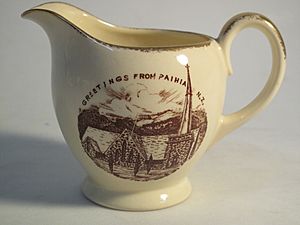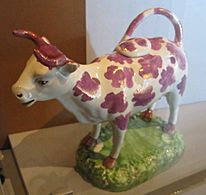Creamer (vessel) facts for kids


A creamer is a small pitcher or jug. It is used to hold cream or milk. People serve cream or milk with tea or coffee, especially in Western countries. Creamers can be made from clay, like earthenware or porcelain. They can also be made from silver or other metals. A creamer is a key part of a coffee or tea set.
Cow Creamers: Fun and Functional
Creamers shaped like a cow are called cow creamers. They have an opening or lid on their back. This is where you pour in the cream or milk. These fun creamers first appeared in Holland. They became very popular in England.
The first English cow creamers were imported from Holland. Then, around 1740, English potters started making them. These were often made from saltglaze stoneware in the Staffordshire Potteries. Silver cow creamers appeared in England around 1750. A Dutch silversmith named John Schuppe moved to London in 1753. He made many beautiful silver cow creamers.
Cow creamers are still made today. You can find them in both silver and ceramic. The Potteries Museum & Art Gallery has a huge collection. It includes 667 ceramic cow creamers!
Espresso Brew Pitchers
Small metal creamers have another use. They can help make espresso-based drinks. Baristas brew the espresso right into these small pitchers. Then, they pour the espresso into the drink. In this case, they are called espresso brew pitchers. Sometimes they are just called "small creamers."
Most brew pitchers hold about 89 millilitres (3 US fl oz) of liquid. This is enough for most espresso shots. Larger sizes are also available. Some hold 150 millilitres (5 US fl oz) or even 240 millilitres (8 US fl oz).
Espresso brew pitchers are very useful for making layered latte macchiatos. These drinks need careful pouring. For other drinks, people might use a small espresso cup. But a pitcher makes pouring much easier.



